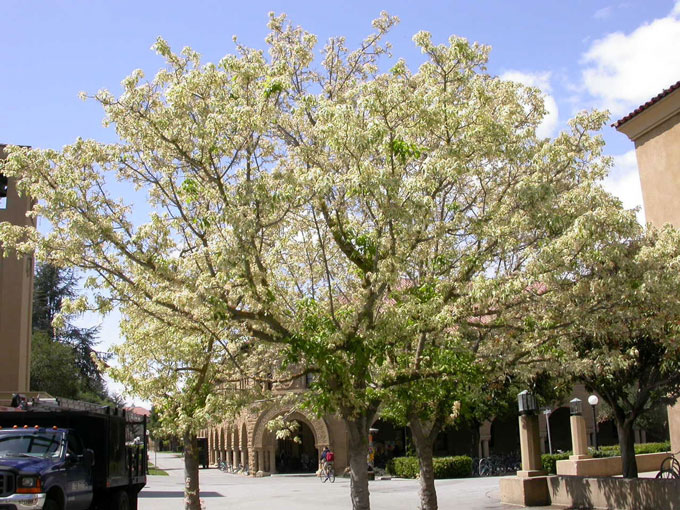Acer negundo
 box elder
box elder
Leaves like an ash distinguish this maple. Three specimens of ‘Variegatum’, which originated in France in 1845, can be seen adjacent to the Clock Tower in a circular bed at the southwest corner of the School of Education (corner of Escondido and Lasuen malls). The white-fringed leaves and balls of unusually colored samaras attract attention. In late 2013 or early 2014 an additional trio was added at the end of the same planting bed, and in late 2017 or early 2018 yet another trio appeared along the same axis but on the other side of Meyer Green.
Acer negundo var. californicum is native to stream banks around Stanford and may be found growing in San Francisquito Creek at Junipero Serra Boulevard and Sand Hill Road and at Jasper Ridge. The leaf, which usually consists of three (sometimes five) well-separated leaflets on their own stalks, paler and slightly hairy underneath, is distinctly unlike a maple leaf, but the paired keys are unmistakable.
A feature of box elder is the strict division into male and female trees; most maples are bisexual (and in several different ways). Original box elder is not highly regarded in the Eastern states, but was used by Native Americans up and down the Missouri River for making sugar. The word negundo is from Sanskrit nirguṇḍī, a name current in India for species of Vitex.
Illustrations: samaras | leaf of A. negundo var. californicum, whose leaflets are densely hairy beneath | Jasper Ridge photo archive.
Name derivation: Acer – Latin for maple; negundo – from the native name of Vitex negundo (supposed similarity of leaf).
About this Entry: The main text of this entry is from the book Trees of Stanford and Environs, by Ronald Bracewell, published 2005. Family name updated from Aceraceae to Sapindaceae Oct 2017 (SP). Additional plantings of trios noted (SP, Apr 2018).





